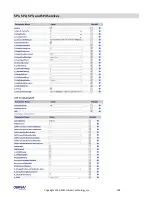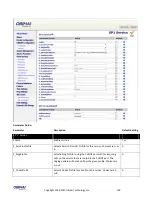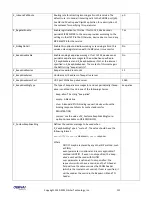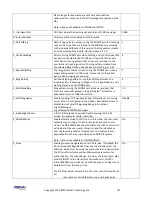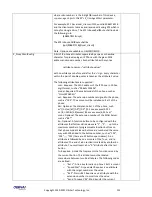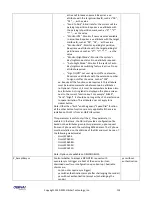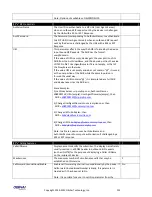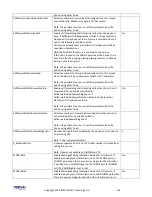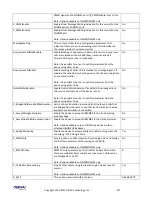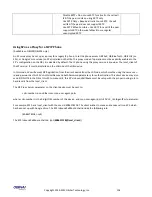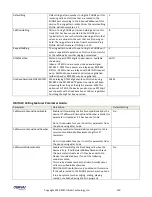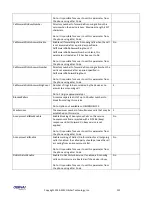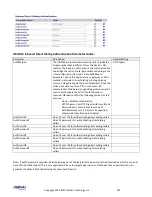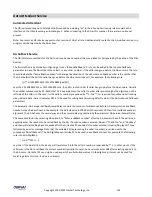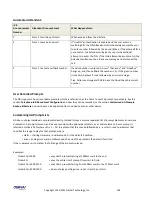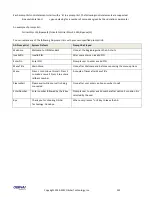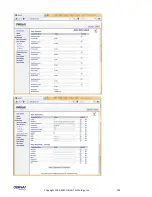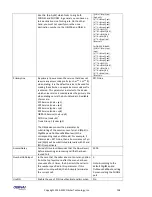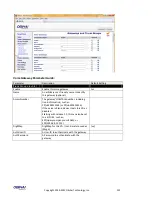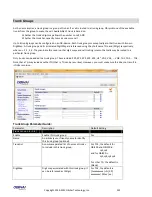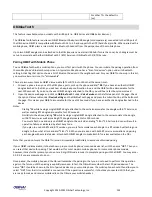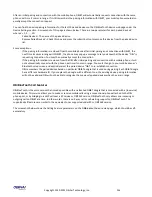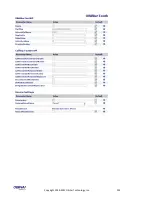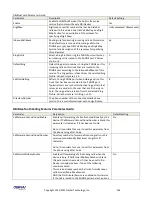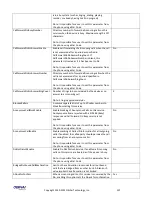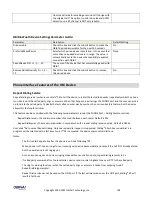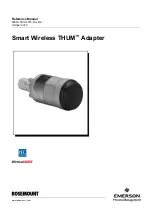
Copyright 2010-2013 Obihai Technology, Inc.
123
Auto Attendant Service
Automated Attendant
The OBi call processing Auto Attendant (AA) invoked by including “aa” in the inbound call routing rule associated the
interface on the OBi processing an incoming call. When connecting to the AA in this manner, there are two options at
present.
Note: At present an OBi device supports only 1 session of AA at a time. Additional calls routed to the AA while a session is in
progress will be rejected by the AA as busy.
AA Callback Service
The OBi offers two methods for the AA to call you back at a number that you picked (or designated by the admin of the OBi
device).
The first method is by statically configuring a trunk’s InboundCallRoute. A rule can be added to the InboundCallRoute
parameter to have the AA call back the caller’s or any other number, if the caller hangs up before the AA answers. The rule
should indicate that “aa(
callback-number
)” is the target destination of the call, where
callback-number
is the number that
the AA should call back if the caller hangs up before the AA answers the call. For example, the following rule
{(<**1>(14089913313|12121559801)):aa($1)}
says that: if 14089913313 or 12121559801 calls, the call is routed to AA. If caller hangs up before the AA answers, AA calls
the number represented by $1. Recall that $1 is expanded into the caller number after processing by the digit map on the
left side of the colon. In this case it is the caller’s number prepended by **1. The **1 is required for outbound call routing
when AA calls back; here it indicates SP1 is to be used for calling back (assuming default value of the AA OutboundCallRoute
parameter)
The parameter AA Service::CallbackAnswerDelay controls the number of milliseconds before AA answers when a callback
number is specified as shown in the example. The default value is 10000 ms (10 seconds). Without the (
callback-number
)
argument, the AA behaves the normal way and the answer delay is governed by the parameter AA Service::AnswerDelay.
The second method is by selecting AA option 3 to “Enter a callback number” after the AA answers the call. The caller can
explicitly enter the number to be called back by the AA. If a valid number is entered, AA says “Thank You” and “Goodbye”,
and then will start calling back 2 seconds after the current call has ended. If number entered is invalid, AA plays SIT tone
followed by an error message. Note that the variable $1 (representing the caller’s number) is carried over to the
subsequent AA callback call. The AA DigitMap can include $1 to be used in a callback context. For example, the following
rule in the AA DigitMap
(<00:**1$1>|… )
says that if the AA dials 00, the device will transforms it into the caller’s number prepended by **1. In other words, if the
caller wants the AA to callback the current number (typically the case), he can simple enter 00# after selecting option 3 on
the AA menu. Note that $1 can only be used as part of a substitution element in the digit map; it must not be used for
matching elements since its value is unknown.
Summary of Contents for OBi100
Page 54: ...Copyright 2010 2013 Obihai Technology Inc 54...
Page 55: ...Copyright 2010 2013 Obihai Technology Inc 55...
Page 58: ...Copyright 2010 2013 Obihai Technology Inc 58...
Page 75: ...Copyright 2010 2013 Obihai Technology Inc 75...
Page 100: ...Copyright 2010 2013 Obihai Technology Inc 100...
Page 109: ...Copyright 2010 2013 Obihai Technology Inc 109 SP1 SP2 SP3 and SP4 Services...
Page 126: ...Copyright 2010 2013 Obihai Technology Inc 126...
Page 135: ...Copyright 2010 2013 Obihai Technology Inc 135...
Page 140: ...Copyright 2010 2013 Obihai Technology Inc 140...
Page 157: ...Copyright 2010 2013 Obihai Technology Inc 157...
Page 158: ...Copyright 2010 2013 Obihai Technology Inc 158...
Page 159: ...Copyright 2010 2013 Obihai Technology Inc 159...
Page 174: ...Copyright 2010 2013 Obihai Technology Inc 174...
Page 185: ...Copyright 2010 2013 Obihai Technology Inc 185...

